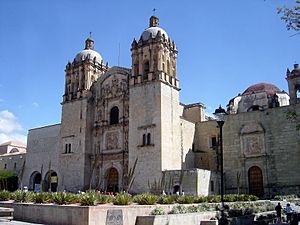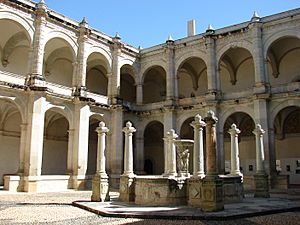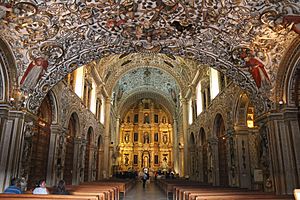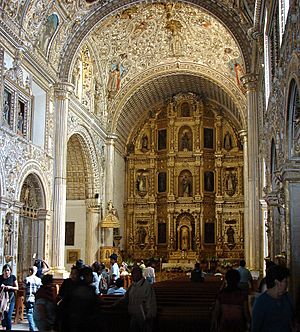Church of Santo Domingo de Guzmán facts for kids
Quick facts for kids Templo de Santo Domingo de Guzmán |
|
|---|---|

Santo Domingo de Guzmán
|
|
| Religion | |
| Affiliation | Roman Catholic |
| Province | Archdiocese of Antequera, Oaxaca |
| Rite | Latin Rite |
| Location | |
| Location | Oaxaca de Juárez, Mexico |
| Architecture | |
| Architectural type | Latin Cross |
| Architectural style | Baroque |
| Groundbreaking | 1572 |
| Completed | 1724 |
| Materials | Cantera |
The Church and Convent of Santo Domingo de Guzmán is a famous landmark in the city of Oaxaca de Juárez, Mexico. It is a stunning example of New Spanish Baroque architecture. This style is known for its fancy and detailed designs. The story of this building began in 1551. The city gave land to the Dominican Order, a group of Catholic priests and brothers, to build a convent. The main buildings were finally opened in 1608.
Over the years, this beautiful place has seen a lot of Mexican history. It was used as a military building and even a stable for horses. During a time of conflict called the Reform War, the government closed it for religious services. Later, President Porfirio Díaz returned it to the Church.
In 1979, Pope John Paul II visited the church. Today, it is part of a UNESCO World Heritage Site, along with the historic center of Oaxaca. This means it is recognized as a place of great cultural importance for the whole world.
Contents
The Long History of Its Construction
The first members of the Dominicans came to Oaxaca around 1528. A few years later, in 1551, the city gave them land to build their convent. The Dominicans promised to finish the building in 20 years. But by 1572, they had not made much progress.
The city council gave them 30 more years to finish. In return, the Dominicans helped pay for a system to bring clean water to the city. Building the convent was slow because it was hard to get enough money.
Why Did Construction Speed Up?
In the early 1600s, two earthquakes hit Oaxaca. The quakes in 1603 and 1604 destroyed another convent in the city. This disaster made everyone realize they needed to finish Santo Domingo quickly. The main part of the convent was officially opened in 1608.
By 1623, it even became a small university. Students could study subjects like philosophy and religion there. The final decorations on the church were finished in 1666. The last major part, the Chapel of the Rosary, was built in 1724.
A Center of Mexican History
Starting in 1812, the church and convent were used by armies. During the Mexican War of Independence, different groups fighting for control of Mexico took over the building.
Later, in 1859, new laws from President Benito Juárez's government turned the convent into a military base. For a while, Catholic services were stopped by the government. But in 1902, President Porfirio Díaz gave the property back to the Church.
Architectural Features
The front of the church is very impressive. It has carvings of Saint Dominic and Saint Hippolytus. They are shown holding up a model of a church. The two bell towers have arched windows and tall spires. Their domes are covered in colorful tiles called azulejos.
The Santo Domingo complex has two main parts. One is the church, which is still an active place of worship. The other is the old convent, which is now a museum.
The Cultural Center of Oaxaca
The rooms of the old convent are now home to the Cultural Center of Oaxaca. The famous artist Francisco Toledo helped create this museum. It has many amazing artifacts from the history of the Oaxaca region.
One of the most important displays is from Tomb 7 of Monte Albán. This tomb held treasures from the ancient Mixtec culture. These items were discovered by the archaeologist Alfonso Caso.
The Ethnobotanical Garden
The convent's old garden is now the Oaxaca Ethnobotanical Garden. This special garden is filled with plants that are native to the state of Oaxaca. It shows the rich variety of plant life in the region.
To get to the church and museum, you walk through a large plaza. This open square is a popular spot for festivals and fun events. It connects to the city's main square through a pedestrian-only street. This street is a favorite place for both tourists and locals to take a walk.
Additional Images
-
.
The former convent garden, now maintained as an ethnobotanical garden.
See also
 In Spanish: Templo de Santo Domingo de Guzmán (Oaxaca) para niños
In Spanish: Templo de Santo Domingo de Guzmán (Oaxaca) para niños














